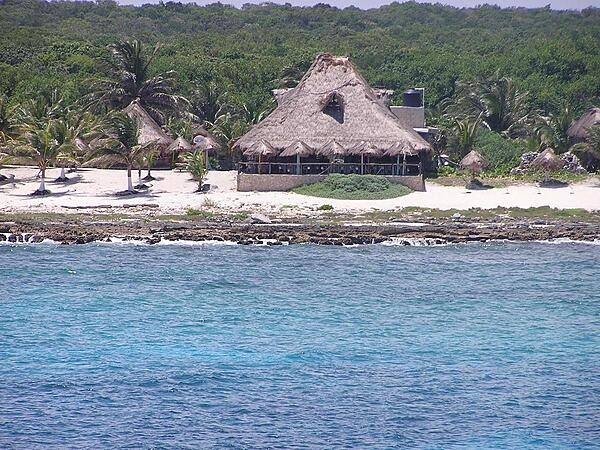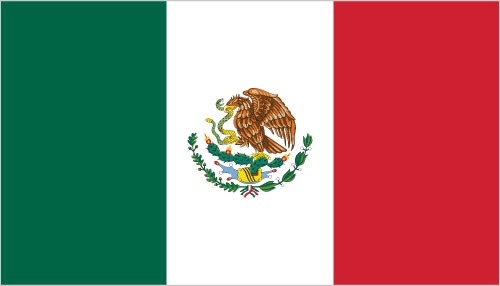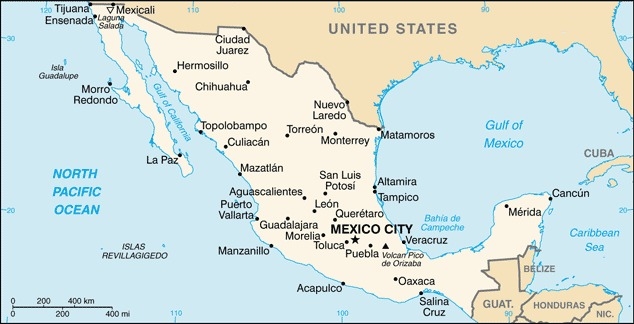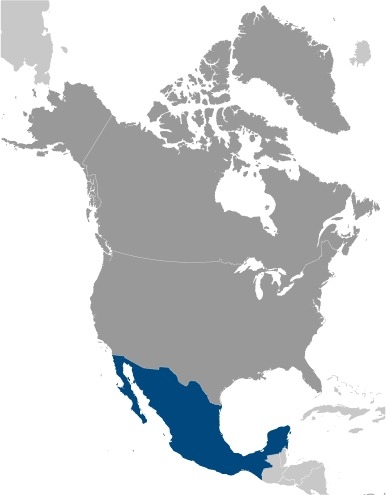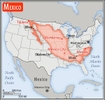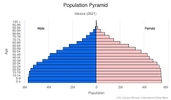Mexico
Introduction
Background
The site of several advanced Amerindian civilizations - including the Olmec, Toltec, Teotihuacan, Zapotec, Maya, and Aztec - Mexico was conquered and colonized by Spain in the early 16th century. Administered as the Viceroyalty of New Spain for three centuries, it achieved independence early in the 19th century. Elections held in 2000 marked the first time since the 1910 Mexican Revolution that an opposition candidate - Vicente FOX of the National Action Party (PAN) - defeated the party in government, the Institutional Revolutionary Party (PRI). He was succeeded in 2006 by another PAN candidate Felipe CALDERON, but Enrique PENA NIETO regained the presidency for the PRI in 2012. Left-leaning antiestablishment politician and former mayor of Mexico City (2000-05) Andres Manuel LOPEZ OBRADOR, from the National Regeneration Movement (MORENA), became president in December 2018.
The global financial crisis in late 2008 caused a massive economic downturn in Mexico the following year, although growth returned quickly in 2010. Ongoing economic and social concerns include low real wages, high underemployment, inequitable income distribution, and few advancement opportunities for the largely indigenous population in the impoverished southern states. Since 2007, Mexico's powerful drug-trafficking organizations have engaged in bloody feuding, resulting in tens of thousands of drug-related homicides.
Visit the Definitions and Notes page to view a description of each topic.
Geography
Location
North America, bordering the Caribbean Sea and the Gulf of Mexico, between Belize and the United States and bordering the North Pacific Ocean, between Guatemala and the United States
Geographic coordinates
23 00 N, 102 00 W
Map references
North America
Area
total: 1,964,375 sq km
land: 1,943,945 sq km
water: 20,430 sq km
Land boundaries
total: 4,389 km
border countries (3): Belize 276 km, Guatemala 958 km, US 3155 km
Coastline
9,330 km
Maritime claims
territorial sea: 12 nm
contiguous zone: 24 nm
exclusive economic zone: 200 nm
continental shelf: 200 nm or to the edge of the continental margin
Climate
varies from tropical to desert
Terrain
high, rugged mountains; low coastal plains; high plateaus; desert
Elevation
highest point: Volcan Pico de Orizaba 5,636 m
lowest point: Laguna Salada -10 m
mean elevation: 1,111 m
Natural resources
petroleum, silver, antimony, copper, gold, lead, zinc, natural gas, timber
Land use
agricultural land: 54.9% (2018 est.)
arable land: 11.8% (2018 est.)
permanent crops: 1.4% (2018 est.)
permanent pasture: 41.7% (2018 est.)
forest: 33.3% (2018 est.)
other: 11.8% (2018 est.)
Irrigated land
65,000 sq km (2012)
Major watersheds (area sq km)
Atlantic Ocean drainage: (Gulf of Mexico) Rio Grande/Bravo (607,965 sq km)
Pacific Ocean drainage: (Gulf of California) Colorado (703,148 sq km)
Major aquifers
Atlantic and Gulf Coastal Plains Aquifer
Major lakes (area sq km)
Fresh water lake(s): Laguna de Chapala - 1,140 sq km
Salt water lake(s): Laguna de Terminos - 1,550 sq km
Population distribution
most of the population is found in the middle of the country between the states of Jalisco and Veracruz; approximately a quarter of the population lives in and around Mexico City
Natural hazards
tsunamis along the Pacific coast, volcanoes and destructive earthquakes in the center and south, and hurricanes on the Pacific, Gulf of Mexico, and Caribbean coasts
volcanism: volcanic activity in the central-southern part of the country; the volcanoes in Baja California are mostly dormant; Colima (3,850 m), which erupted in 2010, is Mexico's most active volcano and is responsible for causing periodic evacuations of nearby villagers; it has been deemed a Decade Volcano by the International Association of Volcanology and Chemistry of the Earth's Interior, worthy of study due to its explosive history and close proximity to human populations; Popocatepetl (5,426 m) poses a threat to Mexico City; other historically active volcanoes include Barcena, Ceboruco, El Chichon, Michoacan-Guanajuato, Pico de Orizaba, San Martin, Socorro, and Tacana; see note 2 under "Geography - note"
Geography - note
note 1: strategic location on southern border of the US; Mexico is one of the countries along the Ring of Fire, a belt of active volcanoes and earthquake epicenters bordering the Pacific Ocean; up to 90% of the world's earthquakes and some 75% of the world's volcanoes occur within the Ring of Fire
note 2: some of the world's most important food crops were first domesticated in Mexico; the "Three Sisters" companion plants - winter squash, maize (corn), and climbing beans - served as the main agricultural crops for various North American Indian groups; all three apparently originated in Mexico but then were widely disseminated through much of North America; avocado, amaranth, and chili peppers also emanate from Mexico, as does vanilla, the world's most popular aroma and flavor spice; although cherry tomatoes originated in Ecuador, their domestication in Mexico transformed them into the larger modern tomato
note 3: the Sac Actun cave system at 348 km (216 mi) is the longest underwater cave in the world and the second longest cave worldwide, after Mammoth Cave in the United States (see "Geography - note" under United States)
note 4: the prominent Yucatan Peninsula that divides the Gulf of Mexico from the Caribbean Sea is shared by Mexico, Guatemala, and Belize; just on the northern coast of Yucatan, near the town of Chicxulub (pronounce cheek-sha-loob), lie the remnants of a massive crater (some 150 km in diameter and extending well out into the Gulf of Mexico); formed by an asteroid or comet when it struck the earth 66 million years ago, the impact is now widely accepted as initiating a worldwide climate disruption that caused a mass extinction of 75% of all the earth's plant and animal species - including the non-avian dinosaurs
Major rivers (by length in km)
Rio Grande river mouth (shared with US [s]) - 3,057 km; Colorado river mouth (shared with US [s]) - 2,333 km
note – [s] after country name indicates river source; [m] after country name indicates river mouth
People and Society
Nationality
noun: Mexican(s)
adjective: Mexican
Ethnic groups
Mestizo (Amerindian-Spanish) 62%, predominantly Amerindian 21%, Amerindian 7%, other 10% (mostly European) (2012 est.)
note: Mexico does not collect census data on ethnicity
Languages
Spanish only 93.8%, Spanish and indigenous languages 5.4%, indigenous only 0.6%, unspecified 0.2%; note -indigenous languages include various Mayan, Nahuatl, and other regional languages (2020 est.)
major-language sample(s):
La Libreta Informativa del Mundo, la fuente indispensable de información básica. (Spanish)
The World Factbook, the indispensable source for basic information.
Religions
Roman Catholic 78%, Protestant/evangelical Christian 11.2%, other 0.002%, unaffiliated (includes atheism) 10.6% (2020 est.)
Age structure
0-14 years: 26.01% (male 17,111,199/female 16,349,767)
15-24 years: 16.97% (male 11,069,260/female 10,762,784)
25-54 years: 41.06% (male 25,604,223/female 27,223,720)
55-64 years: 8.29% (male 4,879,048/female 5,784,176)
65 years and over: 7.67% (male 4,373,807/female 5,491,581) (2020 est.)
Dependency ratios
total dependency ratio: 50.3
youth dependency ratio: 38.8
elderly dependency ratio: 11.4
potential support ratio: 8.7 (2020 est.)
Median age
total: 29.3 years
male: 28.2 years
female: 30.4 years (2020 est.)
Population distribution
most of the population is found in the middle of the country between the states of Jalisco and Veracruz; approximately a quarter of the population lives in and around Mexico City
Urbanization
urban population: 81% of total population (2021)
rate of urbanization: 1.4% annual rate of change (2020-25 est.)
Major urban areas - population
21.919 million MEXICO CITY (capital), 5.259 million Guadalajara, 4.956 million Monterrey, 3.245 million Puebla, 2.522 million Toluca de Lerdo, 2.181 million Tijuana (2021)
Sex ratio
at birth: 1.05 male(s)/female
0-14 years: 1.05 male(s)/female
15-24 years: 1.03 male(s)/female
25-54 years: 0.94 male(s)/female
55-64 years: 0.84 male(s)/female
65 years and over: 0.8 male(s)/female
total population: 0.96 male(s)/female (2020 est.)
Mother's mean age at first birth
21.3 years (2008 est.)
Maternal mortality ratio
33 deaths/100,000 live births (2017 est.)
country comparison to the world: 108Infant mortality rate
total: 11.64 deaths/1,000 live births
male: 13.18 deaths/1,000 live births
female: 10.02 deaths/1,000 live births (2021 est.)
Life expectancy at birth
total population: 76.94 years
male: 74.15 years
female: 79.87 years (2021 est.)
Contraceptive prevalence rate
73.1% (2018)
Drinking water source
improved: urban: 100% of population
rural: 96.6% of population
total: 100% of population
unimproved: urban: 0% of population
rural: 3.4% of population
total: 0% of population (2017 est.)
Current Health Expenditure
5.4% (2018)
Physicians density
2.38 physicians/1,000 population (2017)
Hospital bed density
1 beds/1,000 population (2018)
Sanitation facility access
improved: urban: 99.3% of population
rural: 91.9% of population
total: 97.8% of population
unimproved: urban: 0.7% of population
rural: 8.1% of population
total: 2.2% of population (2017 est.)
Major infectious diseases
degree of risk: intermediate (2020)
food or waterborne diseases: bacterial diarrhea and hepatitis A
vectorborne diseases: dengue fever
note: a new coronavirus is causing sustained community spread of respiratory illness (COVID-19) in Mexico; sustained community spread means that people have been infected with the virus, but how or where they became infected is not known, and the spread is ongoing; illness with this virus has ranged from mild to severe with fatalities reported; as of 6 October 2021, Mexico has reported a total of 3,684,242 cases of COVID-19 or 2,857.49 cumulative cases of COVID-19 per 100,000 population with 216.47 cumulative deaths per 100,000 population; as of 2 October 2021, 49.38% of the population has received at least one dose of COVID-19 vaccine
Literacy
definition: age 15 and over can read and write
total population: 95.2%
male: 96.1%
female: 94.5% (2020)
School life expectancy (primary to tertiary education)
total: 15 years
male: 15 years
female: 15 years (2019)
Unemployment, youth ages 15-24
total: 8.1%
male: 7.8%
female: 8.7% (2020 est.)
Environment
Environment - current issues
scarcity of hazardous waste disposal facilities; rural to urban migration; natural freshwater resources scarce and polluted in north, inaccessible and poor quality in center and extreme southeast; raw sewage and industrial effluents polluting rivers in urban areas; deforestation; widespread erosion; desertification; deteriorating agricultural lands; serious air and water pollution in the national capital and urban centers along US-Mexico border; land subsidence in Valley of Mexico caused by groundwater depletion
note: the government considers the lack of clean water and deforestation national security issues
Environment - international agreements
party to: Biodiversity, Climate Change, Climate Change-Kyoto Protocol, Climate Change-Paris Agreement, Comprehensive Nuclear Test Ban, Desertification, Endangered Species, Hazardous Wastes, Law of the Sea, Marine Dumping-London Convention, Marine Dumping-London Protocol, Marine Life Conservation, Nuclear Test Ban, Ozone Layer Protection, Ship Pollution, Tropical Timber 2006, Wetlands, Whaling
signed, but not ratified: none of the selected agreements
Air pollutants
particulate matter emissions: 20.08 micrograms per cubic meter (2016 est.)
carbon dioxide emissions: 486.41 megatons (2016 est.)
methane emissions: 135.77 megatons (2020 est.)
Climate
varies from tropical to desert
Land use
agricultural land: 54.9% (2018 est.)
arable land: 11.8% (2018 est.)
permanent crops: 1.4% (2018 est.)
permanent pasture: 41.7% (2018 est.)
forest: 33.3% (2018 est.)
other: 11.8% (2018 est.)
Urbanization
urban population: 81% of total population (2021)
rate of urbanization: 1.4% annual rate of change (2020-25 est.)
Revenue from forest resources
forest revenues: 0.1% of GDP (2018 est.)
country comparison to the world: 113Major infectious diseases
degree of risk: intermediate (2020)
food or waterborne diseases: bacterial diarrhea and hepatitis A
vectorborne diseases: dengue fever
note: a new coronavirus is causing sustained community spread of respiratory illness (COVID-19) in Mexico; sustained community spread means that people have been infected with the virus, but how or where they became infected is not known, and the spread is ongoing; illness with this virus has ranged from mild to severe with fatalities reported; as of 6 October 2021, Mexico has reported a total of 3,684,242 cases of COVID-19 or 2,857.49 cumulative cases of COVID-19 per 100,000 population with 216.47 cumulative deaths per 100,000 population; as of 2 October 2021, 49.38% of the population has received at least one dose of COVID-19 vaccine
Waste and recycling
municipal solid waste generated annually: 53.1 million tons (2015 est.)
municipal solid waste recycled annually: 2.655 million tons (2013 est.)
percent of municipal solid waste recycled: 5% (2013 est.)
Major lakes (area sq km)
Fresh water lake(s): Laguna de Chapala - 1,140 sq km
Salt water lake(s): Laguna de Terminos - 1,550 sq km
Major watersheds (area sq km)
Atlantic Ocean drainage: (Gulf of Mexico) Rio Grande/Bravo (607,965 sq km)
Pacific Ocean drainage: (Gulf of California) Colorado (703,148 sq km)
Major aquifers
Atlantic and Gulf Coastal Plains Aquifer
Total water withdrawal
municipal: 14.23 billion cubic meters (2017 est.)
industrial: 6.814 billion cubic meters (2017 est.)
agricultural: 66.8 billion cubic meters (2017 est.)
Total renewable water resources
461.888 billion cubic meters (2017 est.)
Major rivers (by length in km)
Rio Grande river mouth (shared with US [s]) - 3,057 km; Colorado river mouth (shared with US [s]) - 2,333 km
note – [s] after country name indicates river source; [m] after country name indicates river mouth
Government
Country name
conventional long form: United Mexican States
conventional short form: Mexico
local long form: Estados Unidos Mexicanos
local short form: Mexico
etymology: named after the capital city, whose name stems from the Mexica, the largest and most powerful branch of the Aztecs; the meaning of the name is uncertain
Government type
federal presidential republic
Capital
name: Mexico City (Ciudad de Mexico)
geographic coordinates: 19 26 N, 99 08 W
time difference: UTC-6 (1 hour behind Washington, DC, during Standard Time)
daylight saving time: +1hr, begins first Sunday in April; ends last Sunday in October
time zone note: Mexico has four time zones
etymology: named after the Mexica, the largest and most powerful branch of the Aztecs; the meaning of the name is uncertain
Administrative divisions
32 states (estados, singular - estado); Aguascalientes, Baja California, Baja California Sur, Campeche, Chiapas, Chihuahua, Coahuila, Colima, Cuidad de Mexico, Durango, Guanajuato, Guerrero, Hidalgo, Jalisco, Mexico, Michoacan, Morelos, Nayarit, Nuevo Leon, Oaxaca, Puebla, Queretaro, Quintana Roo, San Luis Potosi, Sinaloa, Sonora, Tabasco, Tamaulipas, Tlaxcala, Veracruz, Yucatan, Zacatecas
Independence
16 September 1810 (declared independence from Spain); 27 September 1821 (recognized by Spain)
National holiday
Independence Day, 16 September (1810)
Constitution
history: several previous; latest approved 5 February 1917
amendments: proposed by the Congress of the Union; passage requires approval by at least two thirds of the members present and approval by a majority of the state legislatures; amended many times, last in 2020
Legal system
civil law system with US constitutional law influence; judicial review of legislative acts
International law organization participation
accepts compulsory ICJ jurisdiction with reservations; accepts ICCt jurisdiction
Citizenship
citizenship by birth: yes
citizenship by descent only: yes
dual citizenship recognized: not specified
residency requirement for naturalization: 5 years
Suffrage
18 years of age; universal and compulsory
Executive branch
chief of state: President Andres Manuel LOPEZ OBRADOR (since 1 December 2018); note - the president is both chief of state and head of government
head of government: President Andres Manuel LOPEZ OBRADOR (since 1 December 2018)
cabinet: Cabinet appointed by the president; note - appointment of attorney general, the head of the Bank of Mexico, and senior treasury officials require consent of the Senate
elections/appointments: president directly elected by simple majority popular vote for a single 6-year term; election last held on 1 July 2018 (next to be held in July 2024)
election results:
2018: Andres Manuel LOPEZ OBRADOR elected president; percent of vote - Andres Manuel LOPEZ OBRADOR (MORENA) 53.2%, Ricardo ANAYA (PAN) 22.3%, Jose Antonio MEADE Kuribrena (PRI) 16.4%, Jaime RODRIGUEZ Calderon 5.2% (independent), other 2.9%
2012: Enrique PENA NIETO elected president; percent of vote - Enrique PENA NIETO (PRI) 38.2%, Andres Manuel LOPEZ OBRADOR (PRD) 31.6%, Josefina Eugenia VAZQUEZ Mota (PAN) 25.4%, other 4.8%
Legislative branch
description: bicameral National Congress or Congreso de la Union consists of:
Senate or Camara de Senadores (128 seats; 96 members directly elected in multi-seat constituencies by simple majority vote and 32 directly elected in a single, nationwide constituency by proportional representation vote; members serve 6-year terms)
Chamber of Deputies or Camara de Diputados (500 seats; 300 members directly elected in single-seat constituencies by simple majority vote and 200 directly elected in a single, nationwide constituency by proportional representation vote; members serve 3-year terms)
elections:
Senate - last held on 1 July 2018 (next to be held in July 2024)
Chamber of Deputies - last held on 6 June 2021 (next to be held in July 2024)
election results:
Senate - percent of vote by party - percent of vote by party - NA; seats by party - MORENA 58, PAN 22, PRI 14, PRD 9, MC 7, PT 7, PES 5, PVEM 5, PNA/PANAL 1; composition (as of July 2018) - men 65, women 63, percent of women 49.2%
Chamber of Deputies - percent of vote by party - NA; seats by party - MORENA 197, PAN 111, PRI 69, PVEM 44, PT 38, MC 25, PRD 16; composition - men 250, women 250, percent of women 50%; note - overall percent of women in National Congress 49.8%
note: as of the 2018 election, senators will be eligible for a second term and deputies up to 4 consecutive terms
Judicial branch
highest courts: Supreme Court of Justice or Suprema Corte de Justicia de la Nacion (consists of the chief justice and 11 justices and organized into civil, criminal, administrative, and labor panels) and the Electoral Tribunal of the Federal Judiciary (organized into the superior court, with 7 judges including the court president, and 5 regional courts, each with 3 judges)
judge selection and term of office: Supreme Court justices nominated by the president of the republic and approved by two-thirds vote of the members present in the Senate; justices serve 15-year terms; Electoral Tribunal superior and regional court judges nominated by the Supreme Court and elected by two-thirds vote of members present in the Senate; superior court president elected from among its members to hold office for a 4-year term; other judges of the superior and regional courts serve staggered, 9-year terms
subordinate courts: federal level includes circuit, collegiate, and unitary courts; state and district level courts
Note: in mid-February 2020, the Mexican president endorsed a bill on judicial reform, which proposes changes to 7 articles of the constitution and the issuance of a new Organic Law on the Judicial Branch of the Federation
Political parties and leaders
Citizen's Movement (Movimiento Ciudadano) or MC [Clemente CASTANEDA]
Institutional Revolutionary Party (Partido Revolucionario Institucional) or PRI [Claudia RUIZ Massieu]
It's For Mexico (Va Por Mexico) - alliance that includes PAN, PRI, PRD
Labor Party (Partido del Trabajo) or PT [Alberto ANAYA Gutierrez]
Mexican Green Ecological Party (Partido Verde Ecologista de Mexico) or PVEM [Carlos Alberto PUENTE Salas]
Movement for National Regeneration (Movimiento Regeneracion Nacional) or MORENA [Andres Manuel LOPEZ Obrador]
National Action Party (Partido Accion Nacional) or PAN [Damian ZEPEDA Vidales]
Party of the Democratic Revolution (Partido de la Revolucion Democratica) or PRD [Manuel GRANADOS]
Together We Make History (Juntos Hacemos Historia) - alliance that includes MORENA, PT, PVEM
International organization participation
APEC, Australia Group, BCIE, BIS, CAN (observer), Caricom (observer), CD, CDB, CE (observer), CELAC, CSN (observer), EBRD, FAO, FATF, G-3, G-15, G-20, G-24, G-5, IADB, IAEA, IBRD, ICAO, ICC (national committees), ICCt, ICRM, IDA, IFAD, IFC, IFRCS, IHO, ILO, IMF, IMO, IMSO, Interpol, IOC, IOM, IPU, ISO, ITSO, ITU, ITUC (NGOs), LAES, LAIA, MIGA, NAFTA, NAM (observer), NEA, NSG, OAS, OECD, OPANAL, OPCW, Pacific Alliance, Paris Club (associate), PCA, SICA (observer), UN, UNASUR (observer), UNCTAD, UNESCO, UNHCR, UNIDO, Union Latina (observer), UNWTO, UPU, WCO, WFTU (NGOs), WHO, WIPO, WMO, WTO
Diplomatic representation in the US
chief of mission: Ambassador Esteban MOCTEZUMA Barragan (since 20 April 2021)
chancery: 1911 Pennsylvania Avenue NW, Washington, DC 20006
telephone: [1] (202) 728-1600
FAX: [1] (202) 728-1698
email address and website:
mexembussa@sre.gob.mx
https://embamex.sre.gob.mx/eua/index.php/en/
consulate(s) general: Atlanta, Austin, Boston, Chicago, Dallas, Denver, El Paso (TX), Houston, Laredo (TX), Los Angeles, Miami, New York, Nogales (AZ), Phoenix, Sacramento (CA), San Antonio (TX), San Diego, San Francisco, San Jose (CA), San Juan (Puerto Rico)
consulate(s): Albuquerque (NM), Boise (ID), Brownsville (TX), Calexico (CA), Del Rio (TX), Detroit, Douglas (AZ), Eagle Pass (TX), Fresno (CA), Indianapolis (IN), Kansas City (MO), Las Vegas, Little Rock (AR), McAllen (TX), Milwaukee (WI), New Orleans, Omaha (NE), Orlando (FL), Oxnard (CA), Philadelphia, Portland (OR), Presidio (TX), Raleigh (NC), Saint Paul (MN), Salt Lake City, San Bernardino (CA), Santa Ana (CA), Seattle, Tucson (AZ), Yuma (AZ); note - Washington DC Consular Section is located in a separate building from the Mexican Embassy and has jurisdiction over DC, parts of Virginia, Maryland, and West Virginia
Diplomatic representation from the US
chief of mission: Ambassador (vacant); Charge d'Affaires Stephanie SYPTAK-RAMNATH (since 20 July 2021)
embassy: Paseo de la Reforma 305, Colonia Cuauhtemoc, 06500 Mexico, CDMX
mailing address: 8700 Mexico City Place, Washington DC 20521-8700
telephone: (011) [52]-55-5080-2000
FAX: (011) 52-55-5080-2005
email address and website:
ACSMexicoCity@state.gov
https://mx.usembassy.gov/
consulate(s) general: Ciudad Juarez, Guadalajara, Hermosillo, Matamoros, Merida, Monterrey, Nogales, Nuevo Laredo, Tijuana
Flag description
three equal vertical bands of green (hoist side), white, and red; Mexico's coat of arms (an eagle with a snake in its beak perched on a cactus) is centered in the white band; green signifies hope, joy, and love; white represents peace and honesty; red stands for hardiness, bravery, strength, and valor; the coat of arms is derived from a legend that the wandering Aztec people were to settle at a location where they would see an eagle on a cactus eating a snake; the city they founded, Tenochtitlan, is now Mexico City
note: similar to the flag of Italy, which is shorter, uses lighter shades of green and red, and does not display anything in its white band
National symbol(s)
golden eagle; national colors: green, white, red
National anthem
name: "Himno Nacional Mexicano" (National Anthem of Mexico)
lyrics/music: Francisco Gonzalez BOCANEGRA/Jaime Nuno ROCA
note: adopted 1943, in use since 1854; also known as "Mexicanos, al grito de Guerra" (Mexicans, to the War Cry); according to tradition, Francisco Gonzalez BOCANEGRA, an accomplished poet, was uninterested in submitting lyrics to a national anthem contest; his fiancee locked him in a room and refused to release him until the lyrics were completed
Economy
Economic overview
Mexico's $2.4 trillion economy – 11th largest in the world - has become increasingly oriented toward manufacturing since the North American Free Trade Agreement (NAFTA) entered into force in 1994. Per capita income is roughly one-third that of the US; income distribution remains highly unequal.
Mexico has become the US' second-largest export market and third-largest source of imports. In 2017, two-way trade in goods and services exceeded $623 billion. Mexico has free trade agreements with 46 countries, putting more than 90% of its trade under free trade agreements. In 2012, Mexico formed the Pacific Alliance with Peru, Colombia, and Chile.
Mexico's current government, led by President Enrique PENA NIETO, has emphasized economic reforms, passing and implementing sweeping energy, financial, fiscal, and telecommunications reform legislation, among others, with the long-term aim to improve competitiveness and economic growth across the Mexican economy. Since 2015, Mexico has held public auctions of oil and gas exploration and development rights and for long-term electric power generation contracts. Mexico has also issued permits for private sector import, distribution, and retail sales of refined petroleum products in an effort to attract private investment into the energy sector and boost production.
Since 2013, Mexico’s economic growth has averaged 2% annually, falling short of private-sector expectations that President PENA NIETO’s sweeping reforms would bolster economic prospects. Growth is predicted to remain below potential given falling oil production, weak oil prices, structural issues such as low productivity, high inequality, a large informal sector employing over half of the workforce, weak rule of law, and corruption. Mexico’s economy remains vulnerable to uncertainty surrounding the future of NAFTA — because the United States is its top trading partner and the two countries share integrated supply chains — and to potential shifts in domestic policies following the inauguration of a new a president in December 2018.
Real GDP (purchasing power parity)
$2,306,320,000,000 note: data are in 2017 dollars (2020 est.)
$2,513,410,000,000 note: data are in 2017 dollars (2019 est.)
$2,514,780,000,000 note: data are in 2017 dollars (2018 est.)
note: data are in 2010 dollars
Real GDP growth rate
-0.3% (2019 est.)
2.19% (2018 est.)
2.34% (2017 est.)
Real GDP per capita
$17,900 note: data are in 2017 dollars (2020 est.)
$19,700 note: data are in 2017 dollars (2019 est.)
$19,900 note: data are in 2017 dollars (2018 est.)
note: data are in 2010 dollars
GDP (official exchange rate)
$1,269,956,000,000 (2019 est.)
Inflation rate (consumer prices)
3.6% (2019 est.)
4.9% (2018 est.)
6% (2017 est.)
Credit ratings
Fitch rating: BBB- (2020)
Moody's rating: Baa1 (2020)
Standard & Poors rating: BBB (2020)
GDP - composition, by sector of origin
agriculture: 3.6% (2017 est.)
industry: 31.9% (2017 est.)
services: 64.5% (2017 est.)
GDP - composition, by end use
household consumption: 67% (2017 est.)
government consumption: 11.8% (2017 est.)
investment in fixed capital: 22.3% (2017 est.)
investment in inventories: 0.8% (2017 est.)
exports of goods and services: 37.8% (2017 est.)
imports of goods and services: -39.7% (2017 est.)
Agricultural products
sugar cane, maize, milk, oranges, sorghum, tomatoes, poultry, wheat, green chillies/peppers, eggs
Industries
food and beverages, tobacco, chemicals, iron and steel, petroleum, mining, textiles, clothing, motor vehicles, consumer durables, tourism
Labor force - by occupation
agriculture: 13.4%
industry: 24.1%
services: 61.9% (2011)
Unemployment rate
3.49% (2019 est.)
3.33% (2018 est.)
note: underemployment may be as high as 25%
Population below poverty line
41.9% (2018 est.)
Gini Index coefficient - distribution of family income
36.8 (2018 est.)
48.3 (2008)
Household income or consumption by percentage share
lowest 10%: 2%
highest 10%: 40% (2014)
Budget
revenues: 261.4 billion (2017 est.)
expenditures: 273.8 billion (2017 est.)
Fiscal year
calendar year
Current account balance
-$4.351 billion (2019 est.)
-$25.415 billion (2018 est.)
Exports
$434.93 billion note: data are in current year dollars (2020 est.)
$492.73 billion note: data are in current year dollars (2019 est.)
$480.1 billion note: data are in current year dollars (2018 est.)
Exports - partners
United States 75% (2019)
Exports - commodities
cars and vehicle parts, computers, delivery trucks, crude petroleum, insulated wiring (2019)
Imports
$410.66 billion note: data are in current year dollars (2020 est.)
$495.79 billion note: data are in current year dollars (2019 est.)
$505.05 billion note: data are in current year dollars (2018 est.)
Imports - partners
United States 54%, China 14% (2019)
Imports - commodities
integrated circuits, refined petroleum, cars and vehicle parts, office machinery/parts, telephones (2019)
Reserves of foreign exchange and gold
$175.3 billion (31 December 2017 est.)
$178.4 billion (31 December 2016 est.)
note: Mexico also maintains access to an $88 million Flexible Credit Line with the IMF
Debt - external
$456.713 billion (2019 est.)
$448.268 billion (2018 est.)
Exchange rates
Mexican pesos (MXN) per US dollar -
19.8 (2020 est.)
19.22824 (2019 est.)
20.21674 (2018 est.)
15.848 (2014 est.)
13.292 (2013 est.)
Unemployment, youth ages 15-24
total: 8.1%
male: 7.8%
female: 8.7% (2020 est.)
Energy
Electricity access
electrification - total population: 100% (2020)
Electricity - installed generating capacity
72.56 million kW (2016 est.)
country comparison to the world: 17Electricity - from fossil fuels
71% of total installed capacity (2016 est.)
country comparison to the world: 106Electricity - from nuclear fuels
2% of total installed capacity (2017 est.)
country comparison to the world: 27Electricity - from hydroelectric plants
17% of total installed capacity (2017 est.)
country comparison to the world: 96Electricity - from other renewable sources
9% of total installed capacity (2017 est.)
country comparison to the world: 81Crude oil - proved reserves
6.63 billion bbl (1 January 2018 est.)
country comparison to the world: 19Refined petroleum products - production
844,600 bbl/day (2017 est.)
country comparison to the world: 23Refined petroleum products - consumption
1.984 million bbl/day (2017 est.)
country comparison to the world: 11Natural gas - proved reserves
279.8 billion cu m (1 January 2018 est.)
country comparison to the world: 38Communications
Telephones - fixed lines
total subscriptions: 23,800,105 (2020)
subscriptions per 100 inhabitants: 18.46 (2020 est.)
Telephones - mobile cellular
total subscriptions: 120,481,969 (2020)
subscriptions per 100 inhabitants: 93.45 (2020 est.)
Telecommunication systems
general assessment: with a large population and relatively low broadband and mobile penetration, Mexico’s telecom sector has potential for growth; adequate telephone service for business and government; improving quality and increasing mobile cellular availability, with mobile subscribers far outnumbering fixed-line subscribers; relatively low broadband and mobile penetration, potential for growth and international investment; extensive microwave radio relay network; considerable use of fiber-optic cable and coaxial cable; 5G development slow in part due to high costs; IXP in Mexico City; exporter of computers and broadcasting equipment to USA and importer of same from China (2020)
domestic: competition has spurred the mobile-cellular market; fixed-line teledensity exceeds 18 per 100 persons; mobile-cellular teledensity is about 95 per 100 persons; domestic satellite system with 120 earth stations (2019)
international: country code - 52; Columbus-2 fiber-optic submarine cable with access to the US, Virgin Islands, Canary Islands, Spain, and Italy; the ARCOS-1 and the MAYA-1 submarine cable system together provide access to Central America, parts of South America and the Caribbean, and the US; satellite earth stations - 120 (32 Intelsat, 2 Solidaridad (giving Mexico improved access to South America, Central America, and much of the US as well as enhancing domestic communications), 1 Panamsat, numerous Inmarsat mobile earth stations); linked to Central American Microwave System of trunk connections (2016)
note: the COVID-19 pandemic continues to have a significant impact on production and supply chains globally; since 2020, some aspects of the telecom sector have experienced downturn, particularly in mobile device production; many network operators delayed upgrades to infrastructure; progress towards 5G implementation was postponed or slowed in some countries; consumer spending on telecom services and devices was affected by large-scale job losses and the consequent restriction on disposable incomes; the crucial nature of telecom services as a tool for work and school from home became evident, and received some support from governments
Broadcast media
telecom reform in 2013 enabled the creation of new broadcast television channels after decades of a quasi-monopoly; Mexico has 821 TV stations and 1,745 radio stations and most are privately owned; the Televisa group once had a virtual monopoly in TV broadcasting, but new broadcasting groups and foreign satellite and cable operators are now available; in 2016, Mexico became the first country in Latin America to complete the transition from analog to digital transmissions, allowing for better image and audio quality and a wider selection of programming from networks
Internet users
total: 92.01 million (2021 est.)
percent of population: 71.97% (2020 est.)
Broadband - fixed subscriptions
total: 21,206,911 (2020)
subscriptions per 100 inhabitants: 16.45 (2020 est.)
Transportation
National air transport system
number of registered air carriers: 16 (2020)
inventory of registered aircraft operated by air carriers: 370
annual passenger traffic on registered air carriers: 64,569,640 (2018)
annual freight traffic on registered air carriers: 1,090,380,000 mt-km (2018)
Airports - with paved runways
total: 243
over 3,047 m: 12
2,438 to 3,047 m: 32
1,524 to 2,437 m: 80
914 to 1,523 m: 86
under 914 m: 33 (2017)
Airports - with unpaved runways
total: 1,471
over 3,047 m: 1
2,438 to 3,047 m: 1
1,524 to 2,437 m: 42
914 to 1,523 m: 281
under 914 m: 1,146 (2013)
Heliports
1 (2013)
Pipelines
15,986 km natural gas (2019), 10,365 km oil (2017), 8,946 km refined products (2016)
Railways
total: 20,825 km (2017)
standard gauge: 20,825 km 1.435-m gauge (27 km electrified) (2017)
Roadways
total: 398,148 km (2017)
paved: 174,911 km (includes 10,362 km of expressways) (2017)
unpaved: 223,237 km (2017)
Waterways
2,900 km (navigable rivers and coastal canals mostly connected with ports on the country's east coast) (2012)
country comparison to the world: 33Merchant marine
total: 671
by type: container ship 1, bulk carrier 4, general cargo 11, oil tanker 31, other 624 (2021)
Ports and terminals
major seaport(s): Altamira, Coatzacoalcos, Lazaro Cardenas, Manzanillo, Veracruz
oil terminal(s): Cayo Arcas terminal, Dos Bocas terminal
cruise port(s): Cancun, Cozumel, Ensenada
container port(s) (TEUs): Lazaro Cardenas (1,318,732), Manzanillo (3,069,189), Veracruz (1,144,156) (2019)
LNG terminal(s) (import): Altamira, Ensenada
Military and Security
Military and security forces
Secretariat of National Defense (Secretaria de Defensa Nacional, SEDENA): Army (Ejercito), Mexican Air Force (Fuerza Aerea Mexicana, FAM); Secretariat of the Navy (Secretaria de Marina, SEMAR): Mexican Navy (Armada de Mexico (ARM), includes Naval Air Force (FAN), Mexican Naval Infantry Corps (Cuerpo de Infanteria de Marina, Mexmar or CIM)); Secretariat of Public Security and Civil Protection: National Guard (2021)
note - the National Guard was formed in 2019 and consists of personnel from the former Federal Police (disbanded in December 2019) and military police units of the Army and Navy; while the Guard is part of the civilian-led Secretariat of Public Security and Civil Protection, the Secretariat of National Defense has day-to-day operational control; in addition, the armed forces provide the commanders and the training; the Guard, along with state and municipal police are responsible for enforcing the law and maintaining order
Military expenditures
0.7% of GDP (2021 est.)
0.6% of GDP (2020)
0.5% of GDP (2019)
0.5% of GDP (2018)
0.5% of GDP (2017)
Military and security service personnel strengths
information varies; approximately 223,000 armed forces personnel (160,000 Army; 8,000 Air Force; 55,000 Navy, including about 20,000 marines); approximately 100,000 National Guard (2021)
Military equipment inventories and acquisitions
the Mexican military inventory includes a mix of domestically-produced and imported equipment from a variety of mostly Western suppliers; since 2010, the US is the leading supplier of military hardware to Mexico; Mexico's defense industry produces naval vessels and light armored vehicles (2021)
Military service age and obligation
18 years of age for compulsory military service for males (selection for service determined by lottery); conscript service obligation is 12 months; conscripts remain in reserve status until the age of 40; 16 years of age with consent for voluntary enlistment; cadets enrolled in military schools from the age of 15 are considered members of the armed forces; women are eligible for voluntary military service (20121)
Military - note
the constitution was amended in 2019 to grant the president the authority to use the armed forces to protect internal and national security, and courts have upheld the legality of the armed forces’ role in law enforcement activities in support of civilian authorities through 2024; under these authorities, President LOPEZ OBRADOR has expanded the Mexican military's role in public security duties and other internal tasks; as of 2021, Mexican military operations were heavily focused on internal security duties, particularly in countering drug cartels and organized crime groups, as well as border control and immigration enforcement; in addition, the military has been placed in charge of some infrastructure projects, such as building a new airport for Mexico City and sections of a train line in the country’s southeast; in mid-2020, the armed forces were directed to administer the country’s land and sea ports and customs services in order to fight crime and corruption; the military also runs approximately 2,700 branches of a state-owned bank
Transnational Issues
Disputes - international
abundant rainfall in recent years along much of the Mexico-US border region has ameliorated periodically strained water-sharing arrangements; the US has intensified security measures to monitor and control legal and illegal personnel, transport, and commodities across its border with Mexico; Mexico must deal with thousands of impoverished Guatemalans and other Central Americans who cross the porous border looking for work in Mexico and the US; Belize and Mexico are working to solve minor border demarcation discrepancies arising from inaccuracies in the 1898 border treaty
Refugees and internally displaced persons
refugees (country of origin): 15,676 (Honduras), 9,231 (El Salvador) (2020); 82,976 (Venezuela) (economic and political crisis; includes Venezuelans who have claimed asylum, are recognized as refugees, or have received alternative legal stay) (2021)
IDPs: 357,000 (government's quashing of Zapatista uprising in 1994 in eastern Chiapas Region; drug cartel violence and government's military response since 2007; violence between and within indigenous groups) (2020)
stateless persons: 13 (2020)
Illicit drugs
major source and transit country for heroin, marijuana, methamphetamine, and illicit synthetic drugs including fentanyl and counterfeit pills destined for the United States; main transit country for cocaine from South America, a transit route and destination for fentanyl and associated precursors originating from China
